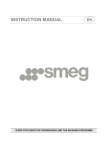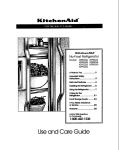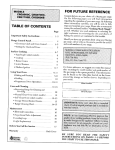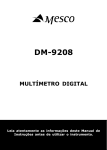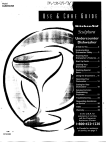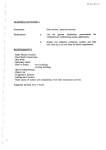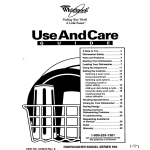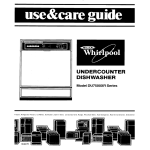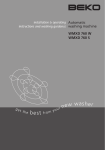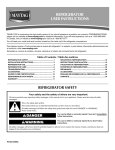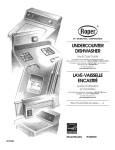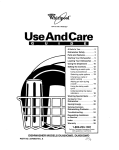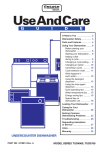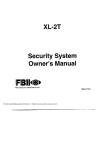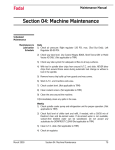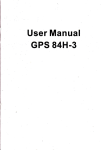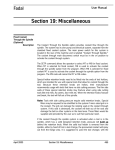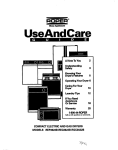Download Model KUDR24SE
Transcript
Model KUDR24SE 9743102 Thank you for buying a KITCHENAID* appliance! KitchenAid designs the best tools for the most important room in your house. To ensure that you enjoy many years of trouble-free operation, we developed this Use and Care guide. It contains valuable information concerning how to operate and maintain your new appliance properly and safely. Please read it carefully. Also, please complete and mail the enclosed Product Registration Card. In the U.S.A. For assistance or service Call the Consumer Assistance Center toll free ................................................ Throughout Canada 1-800-422-1230 for assistance Call the Consumer Assistance Centre toll free ................................................ 1-800-461-5681 8:30 a.m. - 6 p.m. (EST) Throughout Canada for service ...................................................... see page30 If you need assistance or service, first see the "Troubleshooting" section of this book. After checking 'qroubleshooting", additional help can be found by checking the "Requesting Assistance or Service" section, or by calling one of the telephone numbers above. When calling, you will need to know your appliance's complete model number and serial number. You can find this information on the model and serial number label (see diagram on page 4). Keep this book and the sales slip together in a safe place for future reference. You must provide proof of purchase or installation date for in-warranty service. Model Number Builder/Dealer Serial Number Address Date Installed Phone Name Your safety is important to us. This guide contains safety symbols and statements. Please pay special attention to these symbols and follow any instructions given. Here is a brief explanation of the use i This symbol alerts you to hazards such as fire, electdcal shock, or other injuries. of the symbol. IMPORTANT SAFETY INSTRUCTIONS WARNING - When using the dishwasher, follow basic precautions, including the following: • Remove the door to the washing compartment when removing an old dishwasher from service or discarding it. • Read all instructions dishwasher. • For a grounded, cord connected dishwasher. before using the • Use the dishwasher only for its intended function. • Use only detergents or rinse agents recommended for use in the dishwasher, and keep them out of the reach of children. • When loading items to be washed: 1) Locate sharp items so that they are not likely to damage the door seal; and 2) Load sharp knives with the handles up to reduce the risk of cut-type injuries. • Do not wash plastic items unless they are marked "dishwasher safe" or the equivalent. For plastic items not so marked, check the manufacturer's recommendations. • Do not touch the heating element during or immediately after use. • Do not operate the dishwasher unless all enclosure panels are properly in place. • Do not tamper with controls. • Do not abuse, sit on, or stand on the door or dish racks of the dishwasher. • To reduce the risk of injury, do not allow children to play in or on the dishwasher. • Under certain conditions, hydrogen gas may be produced in a hot water system that has not been used for two weeks or more. HYDROGEN GAS IS EXPLOSIVE. If the hot water system has not been used for such a period, before using the dishwasher turn on all hot water faucets and let the water flow from each for several minutes. This wile release any accumulated hydrogen gas. As the gas is flammable, do not smoke or use an open flame during this time. L GROUNDING INSTRUCTIONS The dishwasher must be grounded. In the event of a malfunction or breakdown, grounding will reduce the risk of electrical shock by providing a path of least resistance for electric current. The dishwasher is equipped with a cord having an equipment-grounding conductor and a grounding plug. The plug must be plugged into an appropriate outlet that is installed and grounded in accordance with all local codes and ordinances. WARNING - Improper connection of the equipment-grounding conductor can result in a risk of electrical shock. Check with a qualified electrician or service representative if you are in doubt whether the dishwasher is properly grounded. Do not modify the plug provided with the dishwasher; if it will not fit the outlet, have a proper outlet installed by a qualified electrician. For a permanently connected GROUNDING dishwasher: INSTRUCTIONS The dishwasher must be connected to a grounded metal, permanent wiring system, or an equipment-grounding conductor must be run with the circuit conductors and connected to the equipment-grounding terminal or lead on the dishwasher. - SAVE THESE INSTRUCTIONS - Below is an illustration of your appliance with the parts and features called out. To help you find information on specific parts or features quickly, page references are included. Sure-Hold cup shelf (p. 9) Water inlet Upper - spray arm Model and serial Upper rack (pp. 8-9) Sure-Hold is Silverware basket (p. 11) (p. 10) 4-way HYDROSWEEP* Heating Detergent Overflow protection %-_ float (p. 21) (p. 13) Vent_ Rinse agent ). 15) Other features: Stemware holders (p. 9) Sure-Hold clips (p. 9) Control Panel CYCLE MONITOR WAf_ Ftit_& PlY [ I I I EIIJ I lIE WA1ERH_ATli_ C_ • CHILDLOCK C3 OPnON$ WASH SELECTIONS I • . 4 J Cycle pads Option pads Before using your dishwasher Tip Over Hazard Do not use dishwasher until completely installed. Do not push down on open door. Ooing so can result in serious injury or cuts. • Install where dishwasher is protected from the elements. Protect against freezing to avoid possible rupture of fill valve. Such ruptures are not covered by the warranty. See winter storage information on page 22, • Install and level dishwasher on a floor that will hold the weight, and in an area suitable for its size and use. • Remove all shipping plugs from hoses and connectors (such as the cap on the drain outlet) before installing. See Installation Instructions for complete information. Electrical Shock Hazard Electrically ground dishwasher. Connect ground wire to green ground connector in terminal box. Do not use an extension cord. Failure to do so can result in death, fire, or electrical shock. Using your new KITCHENAID* dishwasher is simple. Follow the steps below to get started. For more information on specific steps and additional safety information, see the page(s) next to the step you would like to know more about. NOTE: Before using your dishwasher, remove all hang tags, temporary labels, and packaging materials. Please also read the entire Use and Care Guide as it contains important operating and safety information. How to use your dishwasher 1. Load the dishwasher. See pages 8-11. 5. Push door firmly when closing. 2. Spin the upper spray arm. It should turn freely. Check the lower spray arm also to make sure 6. Run hot water at sink nearest dishwasher until water is hot. Turn off water. See page 20. it turns freely. 1 3. Add detergent. See pages 13 and 14. 7. Press the desired Wash Selection pad. See the "Cycle selection chart' on page 16. Then press the desired Option(s) pad(s). See page 17 for "Option selections." 4. Add rinse agent if needed. See page 15. 8. Press the Start pad. The cycle will begin (if Delay Hours has not been selected). NOTE: The dishwasher remembers the last cycle and option(s) you selected. You only have to press the Start pad if you want to use the same cycle and option(s). This section tells you how to properly rinsing results. load your dishwasher for the best washing and Preparing to load the dishwasher • Scrape leftover food, bones, toothpicks, and other hard items from dishes. It is not necessary to rinse dishes before putting them into the dishwasher. • Load dishes so soiled surfaces face the spray (down or inward). It is important for the water spray to reach all soiled surfaces. • Take care when loading heavy pots or pans into the dishwasher. They can dent the stainless steel interior of the door if they are dropped or bumped. • Make sure pot lids and handles, pizza pans, cookie sheets, etc., do not interfere with the spray arm rotation. • Run a Rinse Only cycle to keep dishes moist if you do not plan to wash them soon. Foods like eggs, rice, pasta, spinach, and cooked cereals may be hard to remove if they are left to dry. Loading the upper rack 1 The upper rack is designed for cups, glasses, and other small items. • Load cups and glasses in the upper rack only, in the rows between the prongs. Placing them over the prongs can cause them to chip or break. • China, crystal, and other delicate items must not touch each other during dishwasher operation. Damage may occur. • Place items so open ends face down for best cleaning and draining. • Load plastic items securely in the upper rack only. Wash only plastic items marked "dishwasher safe". Cup and glass load • Secure lightweight items so they don't overturn during washing. Wedge lightweight items against one another or overlap them with heavier dishes. (See page 9 on using the Sure-Hold clips.) • Load bowls in the center section for best stability. • Racks with teal-colored tips can be adjusted for different loads. Mixedload Loading the upper rack Sure-Hold cup shelf (cont.) Cup sheff Fold down the extra shelf on the top rack to hold additional cups and glasses or small items like long utensils and spatulas. Stemware holders Stemware holder Use the stemware holders (attached to the cup shelf) to keep water goblets, wine glasses, etc., in place and prevent damage during washing. Sure-Hold clips The Sure-Hold clips hold lightweight plastic items like cups, lids, or bowls in place during washing. Move a clip anywhere in the rack by pulling it up and off the tine and repositioning it in another tine. Sure-Hold clip Loading the lower rack The lower rack is designed for plates, pans, casseroles, and utensils. • Load items with cooked-on or dried-on food in the lower rack with soiled surfaces facing in toward the spray. • For maximum capacity and stability of an all plate load, stagger or overlap small plates with large ones. • Load plates side to side along with pots, pans, and large cookware, as shown. \ • Racks with teal-colored tips can be adjusted for different loads. Utensil load • Load soup, cereal, and serving bowls in the rack in a variety of ways depending upon their size and shape. Load bowls securely between the rows of prongs. Do not nest bowls because the spray won't reach their surfaces. • Do not put small items in the lower rack if they are not secured in place. • Do not load items between the bottom rack and the side of the dishwasher tub. This can block the water inlet opening. Mixed load Sure-Hold cup shelf Fold down the extra shelf on the left side of the lower rack to hold small items such as cups or utensils. Loading the silverware • Load the silverware basket while it is in the lower rack or take the basket out for loading on a counter or table. • Mix items in each section of the basket some pointing up and some down. IMPORTANT: Always load sharp items (knives, skewers, forks, etc.) pointing down. • Place small items like baby bottle caps, jar lids, corn cob holders, etc., in the end sections with the hinged covers. Close the covers over the sections to hold small items in place. • Load forks and spoons so they don't nest together. Water spray cannot reach nested items. • The silverware basket can also be removed for easy unloading. Unload or remove the basket before unloading the upper rack to avoid spilling water droplets on the silverware. NOTES: • Don't load silver or silver-plated silverware with stainless steel. These metals can be damaged by contact with one another during washing. • Some foods (such as salt, vinegar, milk products, fruit juices, etc.) can pit or corrode silverware if left on for long periods of time. Use the Rinse Only cycle when silverware is not washed immediately after use. basket Covers If you have any doubts about washing a particular item, check with the manufacturer see if it is dishwasher safe. MATERIAL Aluminum DISHWASHER SAFE? EXCEPTIONS/SPECIAL to INFORMATION Yes High water temperature and detergents may affect finish of anodized aluminum. All aluminum will darken when washed in the dishwasher. This does not affect pan performance. Disposable Aluminum No Do not wash throw-away aluminum pans in the dishwasher. These might shift during washing and transfer black marks to dishes and other items. Bottles and Cans No Wash bottles and cans by hand. Labels attached with glue can loosen in your dishwasher, clog spray arms or the pump, and will reduce washing performance. Cast Iron No Seasoning will be removed and iron will rust. China/ Stoneware Yes Always check manufacturer's recommendations before washing. Antique, hand-painted, or overthe-glaze patterns may fade. Gold leaf can discolor or fade. Crystal Yes Always check manufacturer's recommendations before washing. Some types of leaded crystal can etch with repeated washings. Gold No Glass Yes Gold-colorod flatware will discolor. Milk glass will yellow with repeated washings. HollowHandle Knives No Handles of some knives are attached to the blade with adhesives which may loosen if washed in the dishwasher. Pewter, Brass, and Bronze No High water temperatures and detergent can discolor or pit finish. Plastics Yes Always check manufacturer's recommendations before washing. Ptastics vary in their capacity to withstand high water temperatures and detergents. Load plastics in top rack only. Disposable Plastics No Cannot withstand high water temperatures and detergents. Stainless Steel Yes Run a Rinse Only cycle if not washing immediately. Prolonged contact with food containingsalt, vinegar, milk products, or fruitjuice could damage finish. Sterling Silver or Silver Plate Yes Run a Rinse Only cycle if not washing immediately. Prolonged contact with food containing salt, acid, or sulfide (eggs, mayonnaise, and seafood) can damage finish. Tin No Can rust. Wooden Ware No Wash by hand. Always check manufacturer's recommendations before washing. Untreated wood can warp, crack, or lose its finish. :For best washing results, it is important to use the correct amount of detergent and a rinse agent. Read this section for information on using both properly. The detergent dispenser The detergent dispenser has 2 sections. The smaller Pre-Wash section empties detergent into the dishwasher when you close the door. The larger Main Wash section empties detergent into the dishwasher during the wash cycle. 1. If the dispenser cover is closed, open the cover by rotating the blue button down. Rotate blue button to o_n.-----_ \l 2. Fill the Main Wash section with detergent. The amount of detergent needed depends on the amount of food soil on the dishes and water hardness. See the detergent usage chart on page 14. 3. Close the dispenser cover and fill the Pre-Wash section. Main Wash section Pre-Wash section PRE-WASH \ NOTE: Do not use detergent with the Rinse Only cycle. w Using the detergent What type of detergent dispenser to use • Use automatic dishwasher detergent only. NOTE: Never use soap, hand-dishwashing detergent, or laundry detergent. These products will produce excessive suds which could cause flooding and reduce washing performance. • Follow manufacturer's instructions when using powdered, liquid, or gel dishwasher detergents. Concentrated (Ultra) powdered detergents usually call for lower usage than do standard powdered detergents. How much detergent • Add detergent to the dispenser just before starting the dishwasher. • Keep detergent container tightly closed in a cool, dry place, out of the reach of children. After opening, a box of detergent should stay fresh for about one month. Detergent exposed to moisture over a pedod of time might become caked and ineffective. to use WATER HARDNESS AMOUNT OF DETERGENT Soft to Medium Hard Water 0-6 grains per gallon For normal loads: • Partially fill the Main Wash section (2 tablespoons or 30 grams) • Fill the Pre-Wash section (2 tablespoons or 30 grams) NOTE: Add only 1 tablespoon or 15 grams of detergent to the Pre-Wash section if dishes are prerinsed or water is very soft. For heavily soiled loads: • Fill the Main Wash section (3 tablespoons or 45 grams) • Fill the Pre-Wash section (2 tablespoons or 30 grams) Medium to Hard Water 7-12 grains per gallon • Fill the Main Wash section (3 tablespoons or 45 grams) • Fill the Pre-Wash section (2 tablespoons or 30 grams) Different brands of dishwasher detergent have different amounts of phosphorus for softening water, if you have hard water and use a detergent with a phosphorous content of less than 8.7%, you may need to use more detergent, or use a detergent with a phosphorous content higher than 8.7%. • Excessive amounts of detergent combined with soft water may cause etching of glassware. NOTE: Water hardness may change over a period of time. Contact your local water utility or area water softening company to determine your water hardness, or order water hardness test strip part number 4171690 through the Consumer Assistance Center. I Using the rinse agent dispenser A rinse agent prevents water from forming droplets that can dry as spots or streaks. It also improves drying by allowing water to drain off of the dishes during the final rinse by releasing a small amount of the rinse agent into the rinse water. Your dishwasher is designed to use a liquid rinse agent. Do not use a solid or bar-type rinse agent. Filling the dispenser The rinse agent dispenser holds 5.2 fluid ounces of rinse agent. Under normal conditions, this will last for about three months. You do not have to wait until the dispenser is empty to refill it. Try to keep it full, but be careful not to overfill it. Indicator window Dispenser knob PRE-WASF 1, Make sure the dishwasher door is fully open. 2. Turn the dispenser knob to Open and lift it out. 3. Add rinse agent until the indicator window looks full. If you overfill, the excess rinse agent may overflow the dispenser and cause oversudsing during the wash cycle. 4, Clean up any spilled rinse agent with a damp cloth. 5, Replace the dispenser knob and turn it to Closed. Rinse agent setting The amount of rinse agent released into the final wash can be adjusted. The factory setting is at 2. For most water conditions set the adjuster to 1 or 2. If there are rings or calcium (hard water) spots on dishes, try a higher setting (4, 5, or 6). TO adjust setting Remove the dispenser knob, then turn the adjuster inside the dispenser to the desired setting. Adjuster This section tells you how to operate the dishwasher. Operating your dishwasher properly enables you to obtain the best possible results. Cycle selection chart The dishwasher will wash and dry dishes according to the selections you make on the control )anel. The dishwasher remembers the last cycle and option(s) you selected. You only have to )ress the Start pad if you want to use the same cycle and options. A "/" shows what steps are in each cycle. ! CYCLE Pre-Wash Rinse Main Wash J ,/ ,/ Rinse / Dry ,,( Time (minutes) Water Usage (gallons/liters) got 8.8/33 Use this cycle for hard-to-clean, heavily soiled pots, pans, casseroles, and regular tableware. 1,1,1,181 I'1 "1"1"1 61.5 ,/ 6.6/25 Use this cycle for loads with moderate amounts of food soil. (The energy usage label is based on this cycle.) 6.6/25 Use this cycle for china, crystal, and other delicate items. Use this cycle for rinsing dishes, glasses, and silverware that will not be washed right away. • Do not use detergent with the Rinse Only cycle. t Expect longer cycle times if water entering the dishwasher is not hot enough. Canceling a cycle You can cancel a cycle anytime during the cycle. 2. Let the dishwasher drain completely. 1, Press the Cancel pad once, then wait. is a 5-second pause between the Cancel pressed Thetime Cancel lightiswill glow. and There draining begins. Option selections Press a pad to select an option. If you change your mind, press the pad again to turn the option off. To select a different option, press another pad. High Temp. Wash Select this option, and water will heat during of heavily soiled dishes. Water heating automatic in the wash the mainiswash for better cleaning portions and final rinse of the Pots & Pans cycle, and in the final rinse of the Normal and Light China cycles. Energy Saver Dry Use this option to air dry dishes without heat. agent dispenser filled. Under certain conditions (hard water, empty For best results, keep the rinserinse agent dispenser, plastic items in the load, etc.) you might find some water left on plastics, dishes, and silverware, Delay The Delay Hours light glows when the dishstart. The delay light will turn off when the cycle starts. See page 19 asher has been set for a delayed on "Setting a delay start". _ Control panel lights The Cycle Monitor allows you to see what portion of a cycle your dishwasher is in. The Clean light glows when a cycle has finished. All other lights will turn off. The Clean light will turn off when you open the door. Water Hours Heating The Water Heating light glows while water in the dishwasher action contini WATER HEATING r rinse is heating. Wash or ues while the water heats. CYCLE MONITOR WASH [ II I _1 RINSE II 11 II DRY ] ; ] CLEAN Using Child Lock Child Lock Light To turn Child Lock on Use Child Lock to prevent your dishwasher from being turned on CHILD LOCK accidentally.No wash selections or options can be selected when Child Lock is on, and the dishwasher will not start. Press Energy Saver Dry for 5 seconds. NOTE: You will still be able to open the dishwasher door. Press Energy Saver Dry again for 5 seconds. The Child Lock light will turn off. other lights will be off. The Child Lock light will glow. All To turn Child Lock off Changing a setting During the first 2 minutes of a cycle Press new Wash Selection and Option pads. After the first 2 minutes of a cycle 1. Press the Cancel pad to drain any water 2. Open the door and check the detergent dispenser to be sure it is properly filled for the new cycle. 3. Close the door. 4. Press new Wash Selection and Option pads, then press the Start pad. NOTE: If the dishwasher will not start, make sure Delay Hours has not been selected. and to reset the control. Adding dishes during a cycle You can add an item to the dishwasher during the first 10 minutes of the cycle. 2. Open the door and add the dishes. 3. Close the door. 1. Unlatch the door to stop the cycle. Wait a few seconds for the spray action to stop before opening the door. 4. The dishwasher will start automatically after a 5-second pause when you close the door. Setting a delay start To run your dishwasher at a later time or during off-peak hours, you can delay the start of a cycle for 2, 4, or 6 hours. To delay the start, follow these steps: NOR_ /[ENERGY_ SAVER / [ DELAY/ STA_ 3. Press the Delay Hours pad once for a 2-hour delay start, twice for 4 hours, or three times for 6 hours, then press the Start pad. The number above the Delay Hours pad will glow and the dishwasher will start the cycle in the amount of hours you have selected. Example for delayed Normal cycle with Energy Saver Dry 4. To turn Delay Hours off, press the pad until no number is lit above the pad. 1. Press a Wash Selection pad for the desired cycle. See chart on page 16 for cycle descriptions. IMPORTANT: 2. Press a pad to select an option. If you change your mind, press the pad again to turn the option off. To select a different option, press another pad. See page 17 for option selections. • If your home is equipped with a water softener, make sure the dishwasher is not timed to start during regeneration of the softener. Drying system During drying, vapor escapes through the vent at the upper left corner of the door. This is normal. The vapor is the result of moisture in the dishwasher being removed during drying. IMPORTANT: The vapor is hot. Do not touch the vent during drying. • Operate your dishwasher only when you are at home. Quiet operating tips To avoid thumping and clattering noises during operation: • Where possible, load items so they do not touch one another. • Make sure lightweight load items are secured in the rack. NOTE: Keep sink drain plugs inserted during dishwasher operation to prevent noise transfer through drains. • Make sure pot lids and handles, pizza pans, cookie sheets, etc., do not touch the dishwasher sides or interfere with the spray arm rotation. Normal operating sounds Some normal sounds you might hear while the dishwasher is running: • Water being pumped out during drain portion of a cycle. • The fill valve opening or closing and the sound of water entering the dishwasher. • Detergent cup opening. • Pump motor starting. • Items being ground up in the food disposer. • Wash/rinse action of water spray. To minimize noise of water circulating on dishes, see "Loading your dishwasher", on pages 8-11. Energy saving tips • Set your home water heater to provide a minimum of 120°F (49°C) incoming water to the dishwasher. To check water temperature: 1. Run hot water at the faucet closest to your dishwasher. Set a cup under the faucet and place a candy or meat thermometer in it. 2, Run hot water for at least one minute into • Run the dishwasher only with a full load. • Use only the cycle and optionsthat you need. • Run the dishwasher during off-peak hours if your utility company offers reduced rates on electricity during specific times of day. • Run the dishwasher at night during the summer to reduce daytime heat buildup in your home. • Do not rinse dishes before loading. • Use the Energy Saver Dry option. overflow. Check the temperature. If the water temperature is 120°F (49°C), haveto thebelow cup, allowing the water a qualified person raise the thermostat setting on your water heater. Your new dishwasher is designed to give you many years of dependable service. However, there are a few things you are expected to do to maintain your dishwasher properly. This section tells you how to clean and care for your dishwasher. HYDROSWEEP* wash system 4-way HYDROSWEEP spray arm The HYDROSWEEP Wash System in your dishwasher provides excellent cleaning results. The wash water is continuously filtered by a triple filtration and soil collector system to prevent food particles from redepositing on clean dishes. The filter The filter continuously filters the wash water and traps the food particles that have been removed from the dishes. A small amount of water will always remain under the filter to keep the pump seal moist. Coarse strainer (not removable) Thewaterjets The food particles are removed from the Ultra-Fine filter by 2 water jets that are located underneath the 4-way HYDROSWEEP arm. The coarse strainer A coarse strainer will prevent bones, pits, and other large objects from entering the pump system. You should periodically check the strainer for such items that may have mistakenly entered the dishwasher. Overflow protection float The overflow protection float in the front right corner of the dishwasher tank prevents the dishwasher from overflowing. The float must be in place for the dishwasher to operate. Check under the float for objects that may prevent the float from moving up or down. I L Check under overflow protection float Storing your dishwasher Moving or winterizing dishwasher your Protect your dishwasher and home against water damage due to freezing water lines. If your dishwasher is left in a seasonal dwelling or could be exposed to near freezing temperatures, have a qualified person do the following: 1. Disconnect power supply to the dishwasher. 2. Turn off water supply to the dishwasher. 3. Remove the 4 screws on the lower access panel and remove the lower access panel. 4. Place a shallow pan under the water supply valve. Then, use a wrench to disconnect the water inlet from the water supply valve. Separate the water inlet from the water supply valve and drain water into the pan. 5. Remove the spring clamp from the water outlet and separate from the water supply valve; drain water into pan. 6. Reconnect both water inlet and water outlet to the water supply valve. Water outlet Spring clamp 7. Empty the pan and reposition it under the water pump. 8. Remove the clamp and disconnect the drain hose from the water pump; drain water into pan. 9. Reconnect drain hose to the water pump, being sure to position the clamp over the connection. 10. Replace the lower access panel. NOTE: If your dishwasher is connected to a garbage disposal, do not run water into the sink after winterizing. This could cause water to refill the drain hose on your dishwasher. Reconnecting after storage your dishwasher 1. Remove the 4 screws on the lower access panel and remove lower access panel. 2. Turn on the water supply to dishwasher. 3. Turn on power supply to dishwasher. Storing 4. Run dishwasher through a complete cycle and check for leaks. Protect your dishwasher during the summer months by turning off the water supply and power supply to the dishwasher. 5. Replace lower access panel. for the summer I I I Cleaning your dishwasher Cleaning the interior If mineral deposits from hard water accumulate on the interior of your dishwasher, clean with a damp cloth or follow the instructions indicated in "Removing spots and film" on page 26. • Do not clean the dishwasher interior until it has cooled. • Do not use any type of cleanser that may cause foaming or sudsing. Use cleansers made for stainless steel products. • Run the dishwasher through a Normal cycle with detergent after you are finished cleaning the interior. Cleaning the exterior Wipe the control panel, front, and sides with a damp cloth, then dry. Never use detergents or abrasive cleansers which may damage the finish. The drain air gap Check the drain air gap anytime your dishwasher isn't draining well. Some state or local plumbing codes require the addition of a drain air gap between a builtin dishwasher and the home drain system. This device protects your dishwasher against water backing up into it when a drain clogs. The drain air gap is usually located on top of the sink or countertop near the dishwasher. To order drain air gap (part number 300096), contact your local KitchenAid dealer. You can also call 1-800-422-1230 in the U.S.A., or see page 2. NOTE: The drain air gap is an external plumbing device that is not part of your dishwasher. The warranty provided with your dishwasher does not cover service costs directly associated with the cleaning or repair of the external drain air gap. To clean the drain air gap: Clean the drain air gap periodically to ensure proper drainage of your dishwasher. Follow the drain air gap cleaning instructions provided by the manufacturer. With most types, you lift off the chrome cover, unscrew the plastic cap, and then check for any I buildup of soil. Clean, if necessary. I Drain air gap This section explains how you can handle minor performance problems. Check this list before calling for service. If you can't solve your dishwasher's problem, review the "Troubleshooting" charts on pages 27-28 before calling for service information. Dishes are not cleaned completely PROBLEM CAUSE SOLUTION Food soil left on dishes Slowdown of spray arm due to high suds Use only recommended dishwasher detergents, not soap or laundry detergents. Do not overfill the rinse agent dispenser. Wipe up any spills before running a cycle. Improper loading Follow the loading instructions on pages 8-11. Insufficient fill due to low water pressure Your home water pressure should be 20 to 120 psi (138 to 828 kPa) for a proper dishwasher fill. You may need a booster pump on the water supply if the pressure is too low. Use of incorrect, too little, or ineffective detergent Use recommended dishwasher detergents and specified amounts only (see page 14 for amounts), but never use less than one tablespoon. For effective cleaning, use only fresh detergent and store it tightly closed in a cool, dry place. Detergent cakes in dispenser Add detergent just before starting the dishwasher. Use fresh detergent and remove any caked detergent before filling the dispenser. When using Delay Wash, make sure the dispenser is dry before adding detergent. Water temperature too low Set your water heater to ensure that the water entering the dishwasher is at least 120°F (49°C). See page 20 for recommended procedure under "Energy saving tips". Hard water or high mineral content in water Use rinse agent to help eliminate spotting and filming. To remove hard water film, see "Removing spots and film" on page 26. Spotting and filming Water temperature too low is Set your water heater to ensure that the water entering the dishwasher is at least 120°F (49°C). See page 20 for recommended procedure under "Energy saving tips". Use of incorrect detergents Use only recommended dishwasher detergents. Incorrect amount of detergent Heavy soil or hard water usually require the use of extra detergent. See page 14 for recommended detergent amounts. Dishes are not cleaned completely (cont.) PROBLEM CAUSE SOLUTION Spoffing and _mlng(cont.) Use of ineffective detergents For effective cleaning, use fresh dishwasher detergent and store it tightly closed in a cool, dry place. Throw away any lumpy detergent. Insufficient fill due to low Water pressure Your home water pressure should be 20 to 120 psi (138 to 828 kPa) for proper dishwasher fill. You may need a booster pump on the water supply if the pressure is too low. Rinse agent not used Fill the rinse agent dispenser. See the instructions on page 15. A water chemical reaction with certain types of glassware - usually caused by some combination of soft or softened water, alkaline washing solutions, insufficient rinsing, excessive detergent, and overloading the dishwasher You may have to hand wash these items to eliminate this problem completely. Silica film and etching are permanent marks and cannot be removed. To slow down the reaction, you can try using as little detergent as possible and a liquid rinse agent. Also, underload the dishwasher to allow thorough rinsing, and use the Energy Saver Dry option. Seasoning removed by dishwasher detergents Reseason your cookware after dishwasher washing. See cookware manufacturer's instructions, or coat pan with cooking oil and wipe clean with a paper towel. Silica film or etching (silica film is a white milky looking deposit; etching is a cloudy film) White spots on eookware with nonstick finish Dishes do not dry completely PROBLEM CAUSE SOLUTION Dishes are not dry Water temperature is too low Set your water heater to ensure that the water entering the dishwasher is at least 120°F (49°C). See page 20 for recommended procedure under "Energy saving tips". Water does not drain off of dishes Do not overload the dishwasher so that the water can drain off the dishes adequately, and use a liquid rinse agent to help speed drying. See pages 8-11 for proper loading instructions. Do not use the Energy Saver Dry option. Rinse agent not used Fill the rinse agent dispenser. See page 15 for instructions. Plastics Some plastics might need to be towel dried. Energy Saver Dry option used Do not use the Energy Saver Dry option on the next load of dishes. Dishes are damaged during cycle PROBLEM CAUSE SOLUTION Chipping of dishes Improper loading Load dishes and glasses so they are stable and do not stdke together while washing. Moving the racks in and out smoothly will also minimize chipping. NOTE: Hand wash some types of china and glassware, such as antiques and featheredged crystal. Black or gray marks on dishes Removing Aluminum items touching dishes Load aluminum pieces so that they will not rub against dishes during washing. Do not wash throw-away aluminum items in the dishwasher. You can remove aluminum markings by using a mild abrasive cleanser. spots and film Keep the rinse agent dispenser filled with a liquid rinse agent. A dnse agent prevents water from forming droplets and drying as spots or streaks. To remove spots and film on dishes and glasses, or hard water film/lime buildup on the interior of the dishwasher, you may use white vinegar with the following procedure: 1. Load clean dishes and glasses in the dishwasher in regular manner, Do not load silverware or other metals in the dishwasher. 2. Put 2 cups of household vinegar in a glass or dishwasher-safe measuring cup, and stand it upright in the bottom rack. 3. Close the door. 4. Select the Normal cycle and Energy Saver Dry option, then press Start. Do not use detergent. Allow the dishwasher to complete the entire cycle. NOTE: This procedure is intended for occasional use only. Vinegar is an acid and excessive use may damage your dishwasher. Before calling for service... If your appliance fails to operate, review the following list and the "Solving Common Dishwashing Problems" section on pages 24-26 before calling your dealer. This could save you the cost of a service call. Dishwasher is not operating PROBLEM CHECK THE FOLLOWING Dishwasher does not run or stops during a cycle Is the door tightly closed? properly Has the cycle been set correctly? See page 7. Is Child Lock on? See page 18. Has a household fuse or circuit breaker blown or tripped? Is the water supply turned on? If the motor has stopped because of an overload, it will automatically reset itself within a few minutes. If the motor does not start, call for service. Dishwasher will not fill Is the overflow protection float stuck in "up" position? It should move up and down freely. Press down to release. See page 21. Dishwasher seems to run too long Is the incoming water temperature low? The dishwasher will run longer while water automatically heats or if the High Temp. Wash option has been selected. Set your water heater to ensure that the water entering the dishwasher is at least 120°F (49°C). Water remains Wait for the cycle to finish. A small amount of water remaining is normal• in dishwasher Check the drain air gap (if installed). If it is clogged, follow the manufacturer's cleaning instructions. See page 23. Detergent remains in Use fresh detergent and store it tightly closed in a cool, dry place. Throw away any lumpy detergent. covered detergent cup Wait for the cycle to complete itself. White residue appears on front of access panel Some detergents foam a lot and can build up on the access panel• Try using less detergent or a different brand to reduce foaming and eliminate buildup. Odor in the dishwasher Run a Rinse Only cycle at least once or twice a day until a full load is accumulated• Overflow protection float should move up and down freely. See page 21. Noises PROBLEM CHECK THE FOLLOWING Grinding, grating, crunching, or buzzing sounds Has a hard object entered the pump? The sound should stop when the object is ground up. If it does not stop after the next cycle, call for service. See page 20 for =Normal operating sounds". Vapor appears PROBLEM CHECK THE FOLLOWING Vapor from door This is normal when dishwasher is in the drying portion of a cycle. See "Drying system" on page 19. Before calling for assistance or service, please check "Troubleshooting" on pages 27 and 28. It may save you the cost of a service call. If you still need help, follow these instructions. If you need assistance or service in the U.S.A.... Call the KltchenAid Consumer Assistance • Accessory and repair parts sales. • Do-it-yourself repair help. 1-800-422-1230. When calling: _ enter know toll free: Please the purchase date and the complete model and serial number of your appliance (see page 2), This information will help us to better respond to your request. Our consultants provide assistance with: • Features and specifications on our full line of appliances. • Installation information. • Specialized customer assistance (Spanish speaking, hearing impaired, limitedvision, etc.). • Referrals to local dealers, service companies, and repair parts distributors. KitchenAid service technicians are trained to fulfill the product warranty and provide after-warranty service, anywhere in the United States. To locate the authorized KitchenAid service company in your area, you can also look in your telephone directory Yellow Pages. • Use and maintenance procedures. If you need replacement If you need to order replacement pads, we recommend that you only use factory authorized pads. These parts will fit right and work right, because they are made with the same precision used to build every new For further parts ... KITCHENAID* appliance. To locate factory authorized replacement parts in your area, call our Consumer Assistance Center telephone number or your nearest authorized service center. assistance ... If you need further assistance, you can write to KitchenAidwith any questions or concerns at: KitchenAid Brand Home Appliances Consumer Assistance Center c/o Correspondence Dept. 2000 North M-63 Benton Harbor, MI 49022-2692 Please include a daytime phone number in your correspondence. If the dealer, authorized servicer, and KitchenAid have failed to resolve your problem, you can contact the Major Appliance Consumer Action Program (MACAP). MACAP is a group of independent consumer experts that voices consumer views at the highest levels of the major appliance industry. MACAP will in tum inform us of your action. Major Appliance Consumer Action Program 20 North Wacker Drive Chicago, IL 60606 If you need assistance or service in Canada ... For assistance throughout Our consultants Canada, Consumer Assistance Centre toll free, cell the 8:30 a.m.KitchenAid - 6. p.m. (EST): Canada 1-800-461-5681. • Referrals to local dealers. When calling: Please know the purchase date, and the complete model and serial number of your appliance (see page 2). This information will help us to better respond to your request. KitchenAid Canada provide assistance with: • Features and specifications on our full line of appliances. Appliance • Use and maintenance procedures. KltchenAid service technicians are trained to fulfill the product warranty and provide after-warranty service, anywhere in Canada. For service in Canada, call one of the following numbers listed below. Service - Consumer Services OIrect service branches: BRITISH COLUMBIA 1-800-665-6788 ALBERTA 1-800-661-6291 ONTARIO Ottawa area 1-800-267-3456 (except 807 area code) Outside the Ottawa area 1-800-807-6777 MANITOBA, SASKATCHEWAN and 807 area code in ONTARIO QUEBEC ATLANTIC 1-800-665-1683 Montreal (except South Shore) South Shore Montreal 1-800-361-3032 1-800-361-0950 Quebec City Sherbrooke 1-800-463-1523 1-800-567-6966 PROVINCES 1-800-565-1598 If you need replacement If you need to order replacement pads, we recommend that you only use factory authorized pads. These parts will fit right and work right, because they are made with For further parts ... the same precision used to build every new KITCHENAID* appliance. To locate factory authorized replacement parts in your area, call your nearest authorized service centre. assistance ... If you need further assistance, you can write to KitchenAid Canada with any questions or concerns at: Consumer Relations Centre KitchenAid Canada 1901 Minnesota Court Mississauga, Ontario L5N 3A7 Please include a daytime phone number in your correspondence. This index is alphabetical. Look for the word or phrase you are interested in, then look for the page number. TOPIC PAGE ASSISTANCE In Canada .................................................. In the U.S.A ............................................... 30 29 CHILD LOCK ................................................. 18 CLEANING Exterior ....................................................... Interior ........................................................ 23 23 COMMON WASHING PROBLEMS Solving .................................................. 24-26 CONTROL PANEL LIGHTS .......................... 17 CYCLE Canceling ................................................... Selection chart ........................................... 17 16 DELAY START .............................................. 19 TOPIC PAGE MAINTENANCE Cleaning ..................................................... Drain air gap .............................................. HYDROSWEEP* wash system .................. Overflow protection float ............................ Storing ........................................................ 23 23 21 21 22 NOISES Normal operating sounds ........................... Quiet operating tips .................................... 20 20 OPERATING ............................................ OPTIONS Selecting .................................................... 17 OVERFLOW PROTECTION ......................... 21 PARTS/FEATURES DETERGENT How much .................................................. What type ................................................... DISHWASHER OPERATION Adding dishes during cycle ........................ Canceling a cycle ....................................... Changing a setting ..................................... Setting a delay start ................................... Starting .......................................................... 14 14 18 17 18 19 7 16-20 ......................................... RESPONSIBILITIES Owner ........................................................... RINSE AGENT Using .......................................................... SAFETY ........................................................... 4 2 15 3 SERVICE In Canada .................................................. In the U.S.A ............................................... 30 29 SILVERWARE 11 BASKET ................................ DISPENSER Detergent ................................................... Rinse agent ................................................ 13 15 SPECIAL ITEMS Washing tips .............................................. 12 DRAIN AIR GAP ........................................... 23 DRYING SYSTEM ........................................ 19 SPOTS/FILM Removing ................................................... 26 ENERGY Saving ........................................................ FEATURES/PARTS ......................................... FILM/SPOTS Removing ................................................... START UP GUIDE ........................................... 20 4 26 LOADING Lower rack ................................................. 10 Preparing to load .......................................... 8 Silverware basket ....................................... 11 Upper rack .................................................... 8 LOWER RACK .............................................. 10 6 STORING ...................................................... 22 TROUBLESHOOTING .................................. 27 UPPER RACK Loading ......................................................... 8 VAPOR .......................................................... 19 WARRANTY .................................................. 32 WATER Checking temperature ................................ 20 LENGTH OF WARRANTY: KITCHENAID WILL PAY FOR: KITCHENAID WILL NOT PAY FOR: ONE YEAR FULL WARRANTY FROM DATE OF INSTALLATION. Replacement parts and repair labor to correct defects in materials or workmanship. Service must be provided by an authorized KitchenAid servicing outlet. A. Service calls to: SECONDTHROUGHFIFTHYEARLIMITED WARRANTY FROM DATE OF INSTALLATION. Replacement parts for the upper or lower dish rack if the rack rusts due to defective materials or workmanship. Replacement parts for the one-third horsepower motor if defective in materials or workmanship. Replacement parts for the electronic controls if defective in materials or workmanship. LIFETIME WARRANTY FROM DATE OF INSTALLATION. 1. Correct the installation of the dishwasher. 2. Instruct you how to use the dishwasher. 3. Replace house fuses or correct house wiring. 4. Correct house plumbing. B. Repairs when dishwasher is used in other than normal home use. C. Damage resulting from accident, alteration, misuse, abuse, improper installation, or installation not in accordance with local electrical and plumbing codes. D. Any labor costs during the limited warranty. Replacement parts for the heating element if defective in materials or workmanship. E. Replacement parts or repair labor costs for units operated outside the United States or Canada. Replacement parts and repair labor for the stainless steel tub or inner door if the tub or inner door develops water leak caused by rust through as a result of defective materials or workmanship. F. Pickup and delivery. This product is designed to be repaired in the home. G. Repairs to parts or systemscaused by unauthorized modifications made to the appliance. H. In Canada, travel or transportation expenses for customers who reside in remote areas. 11/96 KITCHENAID AND KITCHENAID CANADA DO NOT ASSUME ANY RESPONSIBILITY FOR INCIDENTAL OR CONSEQUENTIAL DAMAGES. Some states or provinces do not allow the exclusion or limitation of incidental or consequential damages, so this exclusion or limitation may not apply to you. This warranty gives you specific legal rights and you may also have other rights which may vary from state to state or province to province. Outside the United States or Canada, a different warranty may apply. For details, please contact your authorized KitchenAid dealer. If you need assistance or service, first see the "Troubleshooting" section of this book. After checking "Troubleshooting", additional help can be found by checking the "Requesting Assistance or Service" section, tn the U.S.A., call our Consumer Assistance Center at 1-800-422-1230. In Canada, call KitchenAid Canada at one of the telephone numbers listed on page 30. KitchenAid Benton Harbor, MI 49022-2692 U.S.A. 9743102 © 1996 KitchenAid, U.SA * Registered trademark/Trademark of KitchenAid, U.S.A., KitchenAid Canada Licensee in Canada. 12_36 Printed in U.S,A.
































